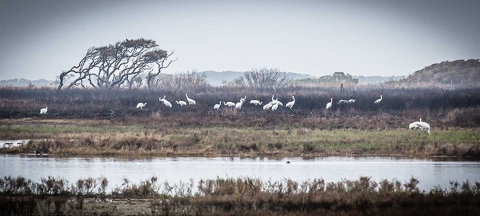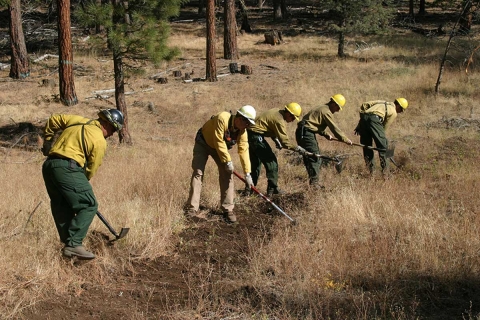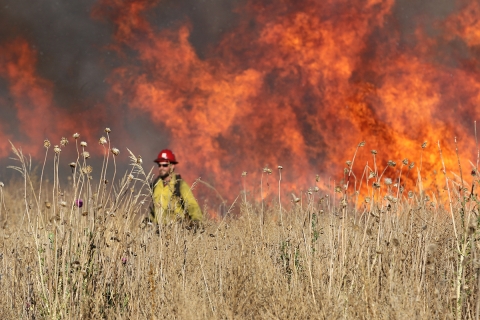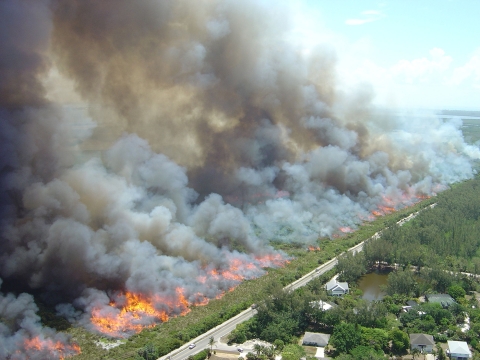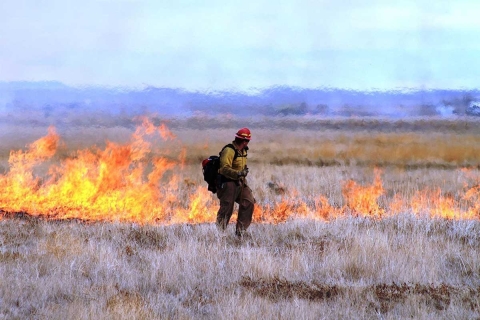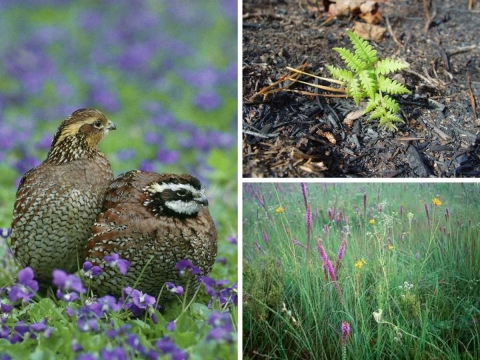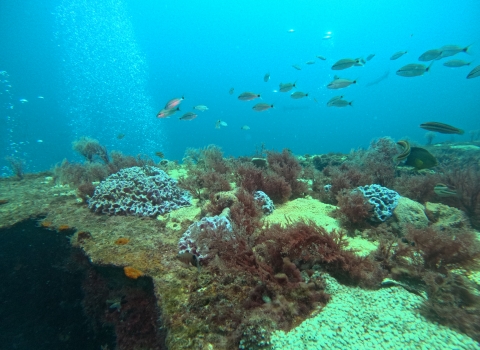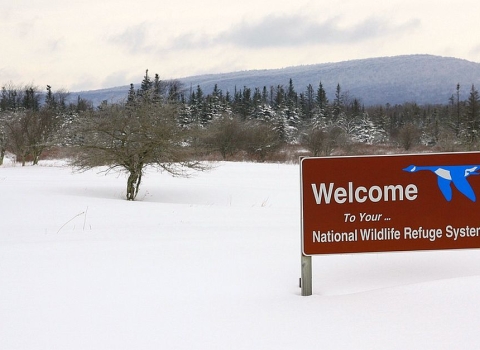Contrary to what many of us learned as kids, fire is not nature’s enemy. Fire used wisely under the right conditions can help restore and enhance fish and wildlife habitat. It can also reduce the risk of catastrophic wildfire.
“The U.S. Fish and Wildlife Service ignited its first prescribed fire in 1927 at St. Marks National Wildlife Refuge in Florida,” says Ed Christopher, a deputy chief of fire management for the Service. “The use of fire to reduce wildfire risk on refuges and neighboring communities has been a Service priority ever since.”
More than 60,000 miles of Service lands are in places where development meets wild lands — places where wildfire poses the greatest risk to people.
Prescribed fire — sometimes called a controlled burn — doesn’t just reduce wildfire risk to surrounding communities; it also helps meet refuge land management goals, such as restoring nesting habitat and controlling invasive weeds. The Service treats roughly 300,000 acres a year with prescribed fire.
The Service also reduces wildfire risk by thinning trees and brush and creating fuel breaks. These strategically placed clearings reduce wildfire intensity and slow fire spread.
See videos of prescribed burns at Okefenokee National Wildlife Refuge in Georgia and Bosque del Apache National Wildlife Apache Refuge in New Mexico.
A prescribed burn is the controlled use of fire to restore wildlife habitat, reduce wildfire risk, or achieve other habitat management goals. We have been using prescribed burn techniques to improve species habitat since the 1930s.
Learn more about prescribed burn . | Image Details
Fire Planning
Prescribed fires on refuges are planned months in advance. Specialists develop a fire plan in consultation with natural resource experts. The plan then goes to the refuge manager for review.
Prescribed burn plans include the purpose of the fire, such as reducing dead brush, removing plant pests or improving animal habitat. Plans also consider local terrain, wildlife and weather patterns. To ensure a fire remains within set boundaries, fire staff may build a fire line, or fuel break, before staging a burn.
Often, Service fire managers conduct burns in partnership with state agencies and other organizations with wildland fire training. These partnerships put more fire personnel and equipment on the scene, boosting safety and the achievement of management goals.
With landowners’ consent, fire managers also conduct prescribed burns on private lands through the Partners for Fish and Wildlife Program, which helps restore wildlife habitat on private lands.
Fire Safety
The safety of firefighters and the public remains a top priority for the Service. All fire personnel must pass a physical and a “pack test,” in which participants wearing 45-pound backpacks must walk three miles in 45 minutes or less. They must also wear special gear, including hard hats, leather gloves and flame-resistant clothing, and carry an emergency personal fire shelter.
The Service has gone more than 35 years without a firefighter fatality. Before that, three Service employees died in fires — one in 1979 at Okefenokee National Wildlife Refuge in Georgia and two in 1981 at Merritt Island National Wildlife Refuge in Florida. For the Service, protecting human life always takes priority over protecting private property and natural resources.
This video describes preparation for a controlled burn.
Fire-Prone Lands
Some landscapes are particularly prone to wildfire. Drought, heat, disease, invasive species invasive species
An invasive species is any plant or animal that has spread or been introduced into a new area where they are, or could, cause harm to the environment, economy, or human, animal, or plant health. Their unwelcome presence can destroy ecosystems and cost millions of dollars.
Learn more about invasive species and poor land management practices can heighten risk for wildfire. Every year, an average 419 wildfires burn more than 500,000 acres on Service lands.
Great Dismal Swamp National Wildlife Refuge in Virginia is a fire-prone landscape. Two centuries of human efforts to drain the swamp left its thick and flammable peat soil even more vulnerable to fire. On August 4, 2011, a lightning storm there struck a tinderbox of easily ignited plant matter, or fuels.
The Lateral West Wildfire burned for 111 days, consuming more than 6,500 acres and producing a thick smoke visible from space. Long-duration fires in peat swamps pose increased health risk to firefighters and the public because of fine particles and gases in the smoke.
To reduce fire risk and better manage water levels, Great Dismal Swamp Refuge completed a $3.13 million project in 2016 to repair and replace water control structures. In coastal North Carolina, Pocosin Lakes National Wildlife Refuge and Alligator River National Wildlife Refuge have also done extensive work to restore their natural hydrology and reduce the risk of long-duration wildfires.
Western areas have also experienced increased wildfire risk. At Washington’s Hanford Reach National Monument and elsewhere, invasive cheatgrass has accelerated the wildfire cycle, imperiling slower-growing plants like native sagebrush sagebrush
The western United States’ sagebrush country encompasses over 175 million acres of public and private lands. The sagebrush landscape provides many benefits to our rural economies and communities, and it serves as crucial habitat for a diversity of wildlife, including the iconic greater sage-grouse and over 350 other species.
Learn more about sagebrush .
“Historically, the natural fire cycle supported sage steppe burning every 90 to 150 years,” says the Service’s national fire ecologist Lou Ballard. “Now we’re seeing these areas burn every five to 10 years. The increase in fires has changed the whole vegetative community. Cheatgrass now dominates the sagebrush steppe, and native plants struggle to return to the landscape.”
Watch a fire whirl pick up tumbleweeds during a prescribed burn to target invasive cheatgrass at Rocky Mountain Arsenal National Wildlife Refuge in Colorado.
Community Protection
Wildfires endanger communities.
In June 2019, lightning sparked the Swan Lake Fire in a remote wilderness area wilderness area
Wilderness areas are places untamed by humans. The Wilderness Act of 1964 allows Congress to designate wilderness areas for protection to ensure that America's pristine wild lands will not disappear. Wilderness areas can be part of national wildlife refuges, national parks, national forests or public lands managed by the Bureau of Land Management.
Learn more about wilderness area at Kenai National Wildlife Refuge in Alaska. Over the summer, the fire spread to more than 160,000 acres, closing the area’s only major highway repeatedly as the fire threatened Cooper Landing and other local communities.
If refuge staff hadn’t thinned trees and placed fuel breaks at the site earlier, the community impact could have been much worse.
Across the country, Service fire managers continue to implement regular cycles of prescribed fire and create and maintain fuel breaks. This active management of resources renews the land and deters wildfires, reducing risks to communities.
Communities adjacent to public lands rely on fire managers to inform and protect them from fire and smoke produced by prescribed burns.
The photo above shows how fire managers at Florida’s J.N. “Ding” Darling National Wildlife Refugedirected smoke from a prescribed burn away from roads and nearby homes. Refuge staff considered prevailing winds when planning the burn.
At Camas National Wildlife Refuge in Idaho, managers planned the controlled burn above to help restore sagebrush habitat, which is vital to species like sage-grouse.
The refuge’s sagebrush habitat has been heavily damaged by plant pests, cattle grazing and frequent wildfires. The controlled burn reduced dry brush and prepared the area for native plant seeding.
Fire-Dependent Species
Fire promotes the germination of more than 200 plant species. Some plants and animals can’t live without fire.
The Southeast’s native longleaf pine is one of these. Beetle-resistant, storm-worthy and tolerant of wet or dry soils, longleafs struggle to survive without fire. “We need fire every year to every three years to maintain healthy longleaf pine forests,” says Ballard.
Red-cockaded woodpeckers, bobwhite quail and songbirds all depend on healthy longleaf forests.
Other fire-adapted species include whooping cranes and sandhill cranes, marsh rabbits, Florida panthers, prairie wildflowers, carnivorous plants, Florida scrub jays and gopher tortoises.


